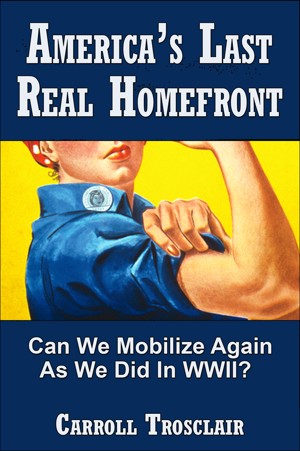Location: United States
Member Since:
June 10, 2012
Carroll Trosclair
Biography
Carroll Trosclair is a retired news editor and public relations executive who grew up in Houma, Louisiana. When he was 11, his family moved to New Orleans a few weeks before the Japanese attacked Pearl Harbor. He has had a keen interest in World War II since his family gathered in their New Orleans apartment to hear radio reports of the attack and President Roosevelt deliver his “day of infamy” speech to Congress the next day.
He was still 15 when the war ended in 1945, so he did not serve during WWII, as his father did. Trosclair was later drafted for the Korean War, but was assigned to the United States occupation of Germany, where American and Russian troops were keeping a close eye on each other while their allies fought in Korea. He was stationed in Vilseck at the Seventh Army Tank Training Center.
Upon returning to the United States he resumed his career as a newsman at the New Orleans States, a now defunct afternoon newspaper. Having earned a journalism degree from Loyola University in New Orleans, he used his GI Bill to get a masters degree in public opinion and propaganda from Louisiana State University in Baton Rouge.
In the following years he served as New Orleans bureau manager for United Press International, as press secretary to U.S. Senator Allen J. Ellender (then president pro-tem of the Senate), as vice president of the Federal Intermediate Credit Bank of New Orleans and as president of two public relations agencies.
He and his first wife, Genevieve Negrotto Trosclair, had three children (Thomas, Mary Lynne Murphy and Gary). She died of cancer in 1994. He later married Betty Brooks Rombach, a long-time friend of the family. They have lived in Kenner, Louisiana since 1997.
He was still 15 when the war ended in 1945, so he did not serve during WWII, as his father did. Trosclair was later drafted for the Korean War, but was assigned to the United States occupation of Germany, where American and Russian troops were keeping a close eye on each other while their allies fought in Korea. He was stationed in Vilseck at the Seventh Army Tank Training Center.
Upon returning to the United States he resumed his career as a newsman at the New Orleans States, a now defunct afternoon newspaper. Having earned a journalism degree from Loyola University in New Orleans, he used his GI Bill to get a masters degree in public opinion and propaganda from Louisiana State University in Baton Rouge.
In the following years he served as New Orleans bureau manager for United Press International, as press secretary to U.S. Senator Allen J. Ellender (then president pro-tem of the Senate), as vice president of the Federal Intermediate Credit Bank of New Orleans and as president of two public relations agencies.
He and his first wife, Genevieve Negrotto Trosclair, had three children (Thomas, Mary Lynne Murphy and Gary). She died of cancer in 1994. He later married Betty Brooks Rombach, a long-time friend of the family. They have lived in Kenner, Louisiana since 1997.
Where to find Carroll Trosclair online
Website: http://www.worldwarmemories.com
Facebook: Facebook profile
LinkedIn: http://www.linkedin.com/profile/edit?trk=tab_pro
Facebook: Facebook profile
LinkedIn: http://www.linkedin.com/profile/edit?trk=tab_pro
Where to buy in print
Books
America's Last Real Home Front
by Carroll Trosclair
Price:
$2.99 USD.
Words: 48,320.
Language:
English.
Published: June 28, 2012
.
Categories:
Nonfiction » History » American, Nonfiction » Politics & Current Affairs » History
Recalling the men, women and kids who conducted America's World War II home front in the greatest mobilization program the world has ever known. Here's how they came from years behind to outproduce the Axis in everything from tanks to bombers, while putting up with higher taxes, shortages, rationing and nearby Uboats. The author also discusses what America must do to ever mobilize that way again

